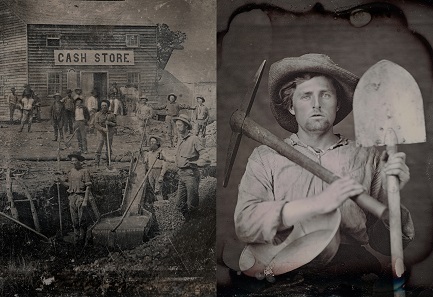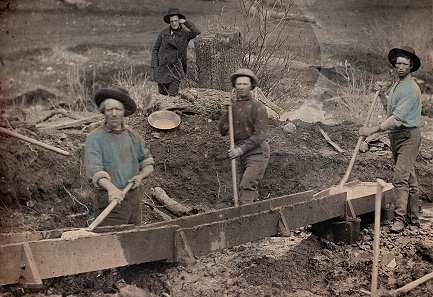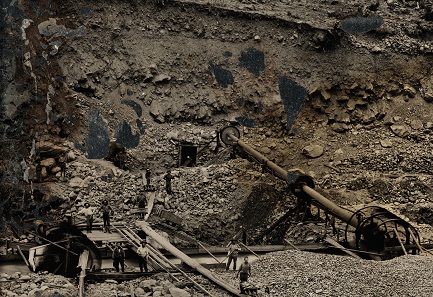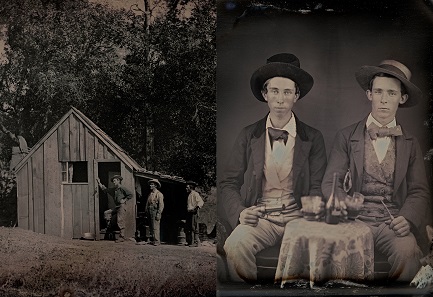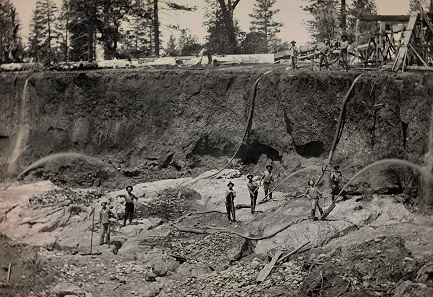March 15, 2018 – The Canadian Photography Institute (CPI) of the National Gallery of Canada presents three exhibitions, each exploring borders, territory, and migration, among which one with a subject of particular interest to numismatists and all those interested in monetary history: “Gold and Silver: Images and Illusions of the Gold Rush”.
Left: Unknown photographer. Outdoor scene with a group of unidentified miners in front of a cash store. c. 1850. Daguerreotype. 1/2 plate (10.8 x 14 cm). // Right: Unknown photographer. Portrait of an unidentified man dressed as a miner with tools. c. 1851. Daguerreotype. 1/6 plate (8.3 x 7 cm).
Organized by the Canadian Photography Institute in partnership with Library and Archives Canada, this exhibition was made possible thanks to the gift of “The Origins of Photography” collection from the Archive of Modern Conflict. More than 150 images, most of them never exhibited before, tell a story of the hopes, dreams, and illusions of an entire generation of pioneers during North America’s two great gold rushes: the California gold rush of 1849, and the Klondike gold rush of 1896, which led to the establishment of the Yukon Territory.
Unknown photographer. Outdoor mining scene at Coloma, California. c. 1854. Daguerreotype with applied colour enhanced with gold. 1/6 plate (8.3 x 7 cm).
In the second half of the 19th century, legions of prospectors left everything behind to set off in search of gold. As the 1850s dawned, the encounter between these new Argonauts and the daguerreotype, a silver-based process only recently invented and the first that was publicly available, was immediate and intense. Forty years later, photography followed the gold rush to the Yukon. The medium underwent a profound transformation in between.
Unknown photographer. Outdoor view of a mining operation. c. 1856. Ambrotype. 1/4 plate (8.3 x 10.8 cm).
While California’s boom-towns slowly faded to ghost towns in the 1870s, Daguerre’s mirror, now obsolete, made way for processes closer to the kind that would later emerge in the 20th century.
Left: Unknown photographer. Exterior view of Aron Perley’s house and four gold miners. 1850. Daguerreotype. 1/4 plate (8.3 x 10.8 cm). // Right: Unknown photographer. Portrait of two unidentified young men drinking liquor. c. 1850. Daguerreotype. 1/6 plate (8.3 x 7 cm).
Two great moments in the history of photography came to pass: between the gold rush of 1848 that began in San Francisco and the 1896 gold rush that began in Dawson City, photography evolved from single images on metal to multiple images on glass or paper.
G.H. Johnson. Outdoor view of a large mining operation on the North Fork American River. c. 1852. Daguerreotype enhanced with gold. Full plate (16,5 x 21.6 cm).
Whether on metal or paper, all of the images have gold in common.
Unknown photographer. Outdoor view of a hydraulic mining operation. c. 1856. Daguerreotype. 1/2 plate (10.8 x 14 cm).
“The fact that we are able to delight in these images today is thanks to the fact that back in their day they were given a gold bath, a metal more noble and stable than silver. For most taken in the 1850s, daguerreotypes present a crispness and exceptional depth, and were often enhanced with colour and touches of gold. The young Argonauts look back at us with shining eyes and seem so close. Photography was fresh and new back then, just like these Western adventurers,” commented the exhibition curator, Luce Lebart, Director of the Canadian Photography Institute and author of the exhibition’s companion book, Gold and Silver, co-published by the Canadian Photography Institute and RVB-BOOKS.
Unknown photographer. Men with a horse-drawn cart, Horse Shoe Bar, North Fork American River, California. August 1851. Daguerreotype. 1/2 plate (10.8 x 14 cm).
Publication
Designed and written by Luce Lebart with RVB-BOOKS, the 128 page publication traces the origins of daguerreotypes, featuring images from the 1849 California gold rush. “Gold and Silver” is a co-publication by the Canadian Photography Institute and RVB BOOKS. Copies are on sale in the Gallery’s Boutique and online for $40. The book is also distributed internationally by RVB-BOOKS.
Visit the website of the National Gallery of Canada and take a look at the Canadian Photography Institute site.
Interested in the gold rush? You will find plenty of material in CoinsWeekly!
Dive into the time of adventurers in this article on Jack London and his fascinating novels.
How did it all begin? With a German, John Augustus Sutter on whose claim in California gold was found in 1848.
And in Part II and Part III you can read how the gold rush continued and why it ended.
Ursula Kampmann travelled to the places where monetary history was written in this time: to Virgina City where in the later 19th century silver deposits, bonanzas, were exploited and to the Old Mint of San Francisco where the gold from the miners’ claims were minted into the first gold coins of the United States.
We can offer you also a film telling the story of the First Gold coins of the United States.




